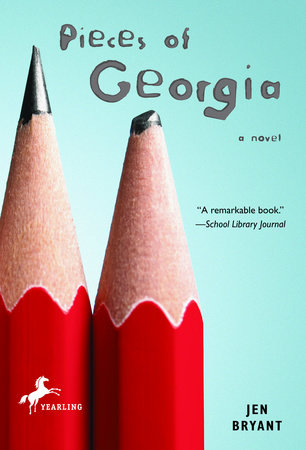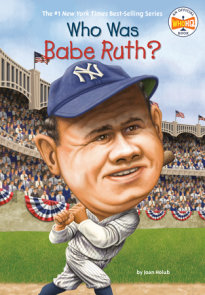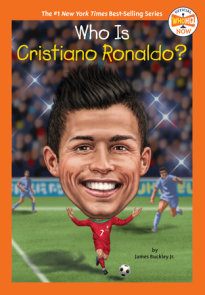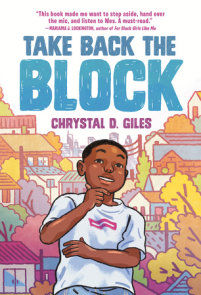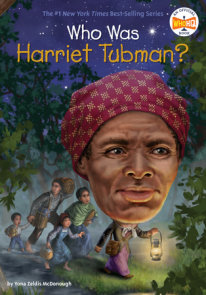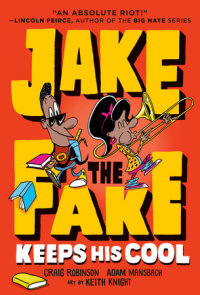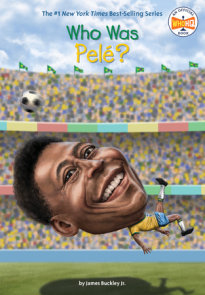TEACHING GUIDE
ABOUT THIS BOOK
Like her mother, Georgia McCoy is an artist, but her dad looks away whenever he sees her with a sketchbook. Sometimes it’s hard to remember what it was like when her mother was still alive . . . when they were a family . . . when they were happy. But then a few days after her 13th birthday, Georgia receives an unexpected gift—a strange, formal letter, all typed up and signed “Anonymous”–granting her free admission to the Brandywine River Museum for a whole year. And things begin to change. An accessible novel in poems, Pieces of Georgia offers an endearing protagonist—an aspiring artist, a grieving daughter, a struggling student, a genuine friend—and the poignant story of a broken family coming together.
ABOUT THIS AUTHOR
“I began by writing biographies and other nonfiction because I loved to research.”–Jen Bryant
From the age of four until she left for college, Jen Bryant lived in an old Victorian house on Main Street in Flemington, NJ. Like Katie Leigh in The Trial, she was extremely independent, curious, and incessantly on the move. “I spent long hours riding my bike from one end of town to the other,” she remembers, “hanging out at the railroad tracks, and poking my head into various shops and small businesses on Main Street.”
Jen was an avid reader since kindergarten, and wanted to work with animals when she grew up. In college, however, she studied French and German and decided to teach in a high school after graduation. In 1988, when her daughter was born, she decided to try writing for children. “I began by writing biographies and other nonfiction because I loved to research,” Jen recalls. “Later, I discovered poetry (which I’d always hated in school) and started to read and write it almost exclusively. Eventually, I combined my love of poetry and research in The Trial, a historical novel-in-verse that describes one girl’s experience at the famous Lindbergh baby kidnapping and murder trial.”
Jen Bryant is the author of numerous biographies for young readers, picture books, and poems. She teaches Writing and Children’s Literature at West Chester University and lives in Glenmoore, Pennsylvania, with her husband and daughter.
TEACHING IDEAS
Pre-Reading Activity
Many artists and their works are mentioned in Pieces of Georgia. Plan to take students to the library to complete background research on the following artists: N. C. Wyeth, Andrew Wyeth, Jamie Wyeth, Georgia O’Keeffe, Paul Gauguin, and Vincent Van Gogh. Divide the class into groups, and assign each group an artist. Each group should research its particular artist and compile a short biography. In addition, each group should find paintings from reference material to share with the class. After each group gives a short presentation, initiate a discussion about the evaluation and appreciation of art work; what appeals to some may not appeal to others at all. While reading the book, have students note which particular paintings are mentioned. After finishing the story, take classes back to the library to see how many of the paintings they can find.
DISCUSSION AND WRITING
Thematic Connections
Grief–Ask the students to define grief. Does everyone handle grief in the same way? What are some of the ways people express grief? Although there is no set pattern for grieving, much research has been done on the following stages:
·Denial (this isn’t happening to me!)
·Anger (why is this happening to me?)
·Bargaining (I promise I’ll be a better person if . . .)
·Depression (I don’t care anymore)
·Acceptance (I’m ready for whatever comes)
Ask students what stage of grief they believe Georgia is in during each of the four parts of the book and why. How about her father? Look at the death of Georgia’s mother from her father’s viewpoint. What new challenges must he face as a single parent? Are the challenges faced by single fathers different from those faced by single mothers?
Besides the loss of a loved one through death, what are some other examples of life incidents that might bring on a feeling of grief and sense of loss? What resources are in school and in the community to help students cope with grief? How might unresolved grief interfere with new relationships? What other books or movies can you think of that center around grief and coming to terms with it?
Personality Traits–Discuss the concept of introverts and extraverts. Georgia by nature is shy and tends to do her best thinking and restore her energy level by doing solitary tasks, such as grooming the horses, walking her dog, or writing in her journal. Other people like Tiffany do their best thinking by talking with others and restore their energy levels by being around other people. Discuss the pros and cons of each type with regard to class participation in school. Is either group more valued by society? What value is there to both types?
Ancestry–Georgia’s grandparents have chosen not to be part of her life. Why is this? Are there significant reasons for some families not to be part of one another’s lives? Georgia wonders about why her parents chose her name. How did your parents decide on you first name, your middle name, or your nickname? Is there a particular story associated with your last name?
Nature vs. Nurture–Are imagination, creativity, and artistic talent traits that you’re born with or skills that can be encouraged through experiences? Georgia’s mother was an artist; does it seem logical Georgia would also have artistic talent? Think about what your parents do for a living. Do your talents lie in the same areas?
Research the Wyeth family and, in particular, how N. C. Wyeth encouraged each of his five children to be creative. What kind of work did each of his children pursue as adults?
Substance Abuse–Substance abuse becomes the only way Tiffany can try to keep up with her overextended schedule and the pressure of meeting everyone’s high expectations. How do you deal with stress and pressure? How else might Tiffany have dealt with her feelings? As a friend, how can you help someone who finds himself thinking about or actually using drugs? For answers to commonly asked questions, including how to talk to a friend without making the problem worse, go to www.drugfree.org/intervention.
What do you do when you feel you’re overextended or the expectations placed on you by others or by yourself are much too high?
Tiffany uses Ritalin to help her cope. Access www.drugfree.org and choose Ritalin under the pull down menu “Drug Descriptions and Effects” to find out more about this and other commonly used drugs. Read and discuss the teen recovery and teen memorial stories posted on this Web site under “Personal Stories.”
SUGGESTED ACTIVITIES
Connecting to the Curriculum
Language Arts–Jamie Wyeth chose to paint a portrait of his wife, Phyllis Mills Wyeth, without having her actually in the picture. He instead chose objects to represent her–a delicate hat with a highlighted white sash suggesting gracefulness hanging over the back of a sturdy straight-back chair. Introduce students to the idea of metaphors by having them think of a very important person in their lives and writing down three objects they associate with that person. The students can then add details and produce three metaphors. For example, “Grandmother, you are the cheesy lasagna you make for me on Sundays.” Ask students to write metaphors for themselves, for a relative, and for a friend.
The author makes good use of imagery throughout the novel. On page 57, she writes, “That hawk–like your one-week pneumonia–must have come out of nowhere, and before you could yell for help or do anything at all about it, it wrapped its claws around you and carried you off.” What other types of things could you compare to death in an attempt to explain it?
Discuss the concept of “Time heals all wounds.” How does this concept begin to apply to Georgia and her father? Write about a time when you or someone close to you felt a great loss and how time has helped or not helped heal the wound.
Using one of the images in the pre-reading activity encourage students to exercise their imaginations by writing a story about it. Begin by having students explore the image through their five senses. If they were to enter the image, what might they see, hear, taste, smell, or touch?
History–The novel introduces three generations–N.C., Andrew, and Jamie Wyeth. Have students research the lives of each artist and include important issues and events during the life time of each man. Does the time in which they each lived seem reflected in their work? If so, how? What can we learn about history, culture, and society through their paintings? Does Georgia seem to gravitate to paintings that revel history or personal sentiments? Can a painting include both?
Introduce students to the idea of using cultural artifacts as primary sources. Ask students to discuss or write about if and/or how creative objects (paintings, novels, poems, songs) dictate how we perceive past time periods. What will today’s art, books, and music convey about our society and culture to future generations?
Art Appreciation–Miss Benedetto, Georgia’s art teacher, tells her students that “Artists notice things that other people don’t . . . they’re very observant.” To test the students’ observation skills in the classroom, have students close their eyes and ask them to describe and/or answer specific questions about objects in the classroom. Have students view the images from the pre-reading activity once more. This time they should concentrate on observing facets of the paintings they did not see before. What differences did they come up with?
In addition to having a keen sense of observation, artists look at objects from unusual perspectives. Jamie Wyeth said, “[The idea] that I am recording something nobody’s looked at before, a unique view. That’s why I paint.” Ask the students to choose an object in the classroom they’ve seen–but maybe never really noticed–everyday since the beginning of school. Then ask them to describe the object from a unique perspective. Explain the concept of using similes (comparison of two unlike things using “like” or “as”) to help the reader paint a picture in his or her mind.
Illustrations are images designed to accompany a written text. Read your students a short story or poem and ask them to illustrate it. Compare the finished works, and discuss the choices an artist must make in creating an illustration.
BEYOND THE BOOK
Partnership for a Drug Free America
www.drugfree.org
Resources and information sponsored for the Partnership for a Drug Free America for parents, caregivers, and teens
Mommy’s Light
www.mommyslight.org
Bereavement support for children, teens, fathers, guardians, and terminally ill mothers
Brandywine Museum
www.brandywinerivermuseum.org
Includes an online 360-degree virtual tour of the N. C. Wyeth Studio
Connect for Kids
www.connectforkids.org/node/296
Article by Alvin Rosenfeld, M.D., and Nicole Wise, co-authors of The Over-Scheduled Child: Avoiding the Hyper-Parenting Trap, focusing on parents who feel pressured into controlling everything in their child’s environment
ABOUT THIS GUIDE
Prepared by Kathryn E. Meyers, Downingtown West High School English Department Faculty, Downingtown, Pennsylvania.
×
Become a Member
Just for joining you’ll get personalized recommendations on your dashboard daily and features only for members.
Find Out More Join Now Sign In






